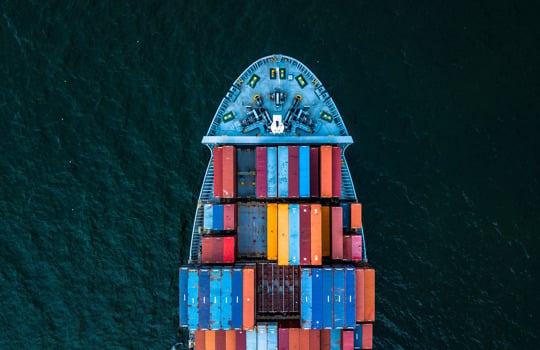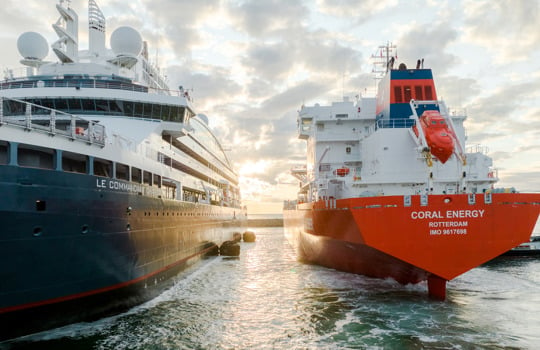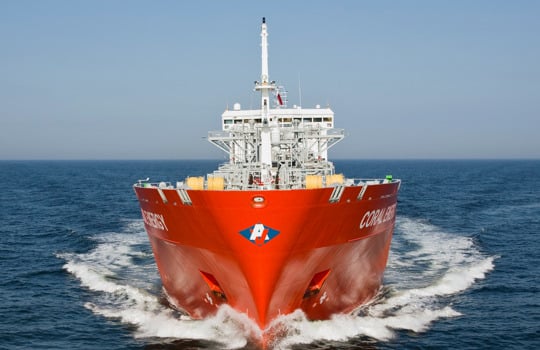LNG and bio-LNG as competitive marine fuel alternatives
There is a growing demand for alternative maritime fuels to reduce the environmental impact of maritime transport. Maritime shipping contributes up to 3% of the world's total CO2 emissions and 10–15% of global sulfur oxides (SOx) and nitrogen oxides (NOx). Meanwhile, 90% of global cargo is transported by sea.
Consequently, the maritime industry faces increased pressure to transition to low-emission fuels. The IMO and EU have set goals and targets for reducing greenhouse gas emissions, but also customers are demanding more sustainable transportation to meet their emission reduction goals.
LNG and renewable liquefied gas for ships
Addressing the tightening emission regulation goals and emission targets of the customers, ship owners are investing in new vessels with engines that can run on alternative fuels. Using liquefied natural gas (LNG) and liquefied biogas (bio-LNG or LBG) as ship fuels is currently the only way to effectively lower maritime emissions. LNG has been used as a fuel in maritime transport for decades. Most of the new LNG vessels are dual fuel, meaning they can use both LNG and conventional fuel or electricity.
With an LNG-powered ship, shipping companies can easily switch to renewable liquefied biogas (bio-LNG) or synthetic LNG (e-LNG) without making modifications or installations, further reducing emissions.
What we deliver
- Trusted and experienced provider of LNG and bio-LNG for ships
- More than 1000 successful and safe bunkering operations in the Nordics and ARA region
- Strong presence in the Baltic Sea and ARA-region
- Flexible delivery solutions and bunkering services
- Bunkering and feedering vessels for ship-to-ship bunkering
- Trailers for truck-to-ship bunkering
- Future proofing solutions: LNG and renewable methane (bio-LNG and e-LNG) as marine fuel
Benefits of LNG and bio-LNG as marine fuel
With liquefied natural gas, LNG, shipping companies can operate freely in sulfur emission control areas (SECA’s). Switching to LNG means complete removal of sulfur oxides (SOx) and particles, and reduction of nitrogen oxides (NOx) emissions of up to 85 percent. LNG reduces CO2 emissions by at least 20 percent. With LNG as a marine fuel, shipping industry can reduce emissions already today.
As a ship fuel, LNG is interchangeable with renewable bio-LNG (liquefied biogas, also called LBG), which produces up to 90% less carbon dioxide emissions than conventional fuel. In the future, there will be renewable synthetic LNG (e-LNG) available which is chemically identical to LNG and bio-LNG. The potential of renewable bio-LNG and e-LNG is significant. The Nordic countries alone could produce over 400 TWh of these renewable fuels, an amount nearly equivalent to the total energy currently used for refueling ships across the EU.
There is excellent availability of liquefied gas and a well-developed infrastructure for distributing the fuel. Since both LNG and bio-LNG consist of methane, companies can switch to, switch between, or blend fuels. With liquefied gas as a fuel, you are future-proof.
Read more about bio-LNG (LBG) >

Download our guide - Pioneering cleaner shipping
We have gathered some information for you in a guide about cleaner maritime transports. You will see what influences shipping to reduce emissions, including regulations, market demands and trends.
Services for shipping companies
In addition to the delivery solutions we offer, our portfolio management services help customers source liquefied gas at a competitive price and make informed EU ETS allowance purchasing decisions.
What is more, our future proofing solutions include sourcing of renewable liquefied gas and green shipping on demand service.
Get to know our services for shipping companies
Contact us for more information on LNG and bio-LNG as marine fuel




